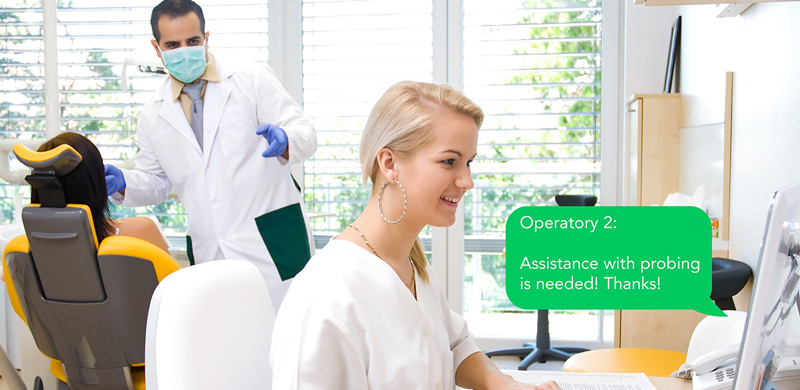
It wouldn’t be an exaggeration to say that every dentist wants their practice to run smoothly. A well-run practice is the key to keeping both your patients and staff happy. In any given dental office, you will find: staff members who wear multiple hats, numerous patients being seen at once, and phones that ring with no end. We have become accustomed to days like these, which have become the new normal.
With patient care always our primary concern, it can be difficult to take the time to complete a proper hand-off, discuss the particulars of treatment, or make sure patients are enjoying their experience.
It is already hard to communicate and collaborate with your team on these busy days. It’s even harder to do so discreetly and without interruption. intra-office communication in dental offices is often put on the back burner, especially if it means any “extra steps.” How do we invest the time, money, and effort to make sure our team is communicating in the best way possible?
Luckily, with digital technology and constantly-evolving software programs, your staff can communicate better than before–without losing any time with patients.
If you spend enough time, you can find an excuse not to do anything. These excuses can discourage dental practices from investing in intra-office communication software.
Let’s shed some light on the objections that are preventing you from providing the best possible care for your patients.
1. We already have strong verbal communication in our practice; why change?
How many times has this happened in your practice?
Ross walks in and tells the front office that he does not want fluoride today. His message is passed on to the hygienist who later tells the dentist, but somehow along the way Ross is still billed for fluoride. As he checks out he is upset because he is billed for the treatment he didn’t want. Having to go through the hassle of now explaining this to the billing coordinator (who was not informed of the situation), Ross is a little irritated and has lost faith in the practice’s ability to listen to his needs.
Could the situation have been handled with better verbal communication? Yes. But it could have been avoided entirely if everyone was on the same page.
Had his fluoride preferences been shared with the office instantly, everyone would have received the same information and Ross would have walked out of the practice happy.
2. We are a smaller (or new) practice, no need for software to communicate.
Understandable, but let’s look at this from another perspective as well.
Ultimately you need to ask yourself this question, “What’s my overall goal for my practice?”
Chances are if you are a smaller or newer practice you are trying to grow. And the only way to grow is by providing exceptional service and creating lasting relationships. Even if you are happy with the size of your practice, you still need to keep your patients happy. Exceptional patient experiences will set you apart from others. For small or newer practices, here is a scenario to consider:
Barbara comes in early. She already has a bit of anxiety and has not been to the dentist in years. This is a new practice, closer to her home. She hopes this environment will ease her anxiety because it is smaller. As Barbara sits in the waiting room she can hear loud drills coming from one of the operatories. This small office cannot hide noise well. Barbara now becomes hyper-aware of the drilling noise. Within a few minutes, she is taken to Operatory 2, where she is seated. A little nervous, Barbara takes a deep breath and can’t help but hear all the neighboring noise from the adjacent room. She hears the hygienist talking to an assistant in the hall about the neighboring patient. She also hears her talking about how they are running behind schedule. She’s now nervous and feeling anxious.
While this story may not happen with the average patient, it’s still likely to happen. Smaller practices have their own unique challenges. Small space means less discretion, more noise and no privacy. If a small practice is trying to grow, provides good service, and is building relationships, they should be aware of all these variables.
When working with patients like Barbara intra-office communication tools such as discrete messaging will come in handy. Instead of staff members talking about patients where others will overhear, they can communicate directly and discreetly from their desktop workstations.
It’s the small things that matter when it comes to building your practice and providing an exceptional patient experience. If additional patient anxieties can be avoided, then why wouldn’t you use alternate methods of communication?
3. This is simply too complicated for us. We have been in business for years. Why use a software program (or an additional program)?
Probably the most common objection to using a new system may seem like an additional step.
Consider this:
Every successful practice needs systems and processes.
If you are a successful practice, chances are you have a set of guidelines and procedures that your office follows. These systems along with practice management software, your billing system, recall, etc. are many parts that make up the whole.
While it is perhaps overwhelming and daunting at times to have so many moving parts, each plays an important role in keeping your business afloat.
Think of an intra-office communication system as another part of the whole! Just as you probably already have a designated person in your practice who handles billing, someone who handles insurance—Appoint someone in the office to champion better communication and best practices with patients.
It does not have to be complicated. Your champion will get everyone else on board while practicing good communication at the same time. We learn the best from our peers, and this can be your opportunity to grow as a practice and improve your business.
We promise, your patients will also take notice, too! Sometimes those “extra steps” are the most rewarding of all as they will help you make huge strides in your patient care.
….
If you could relate to any of the above scenarios, perhaps now is the time to reconsider and reevaluate the way your practice communicates. After all, at the end of the day aren’t we all trying to provide the best possible care for our patients?


